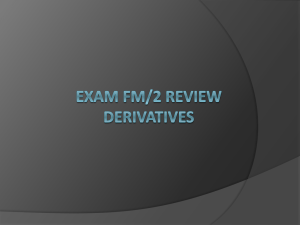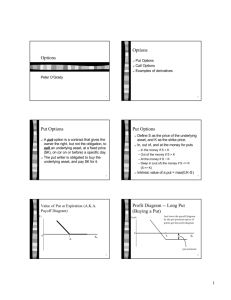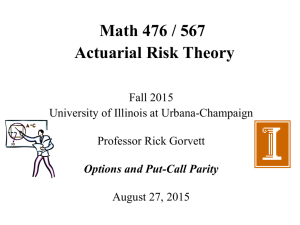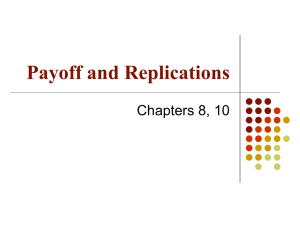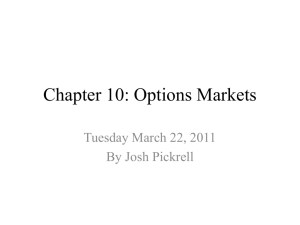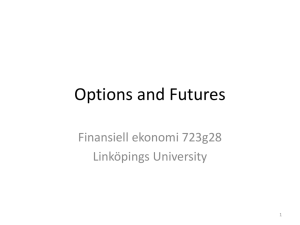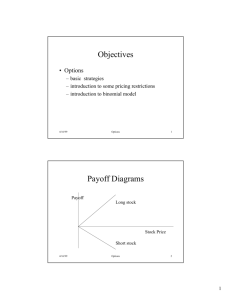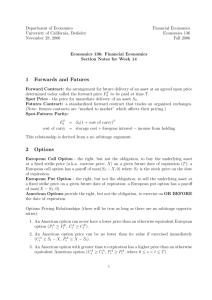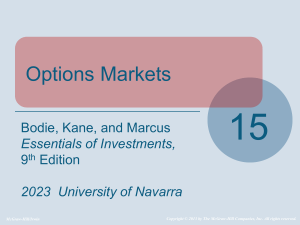0324322321_68887
advertisement
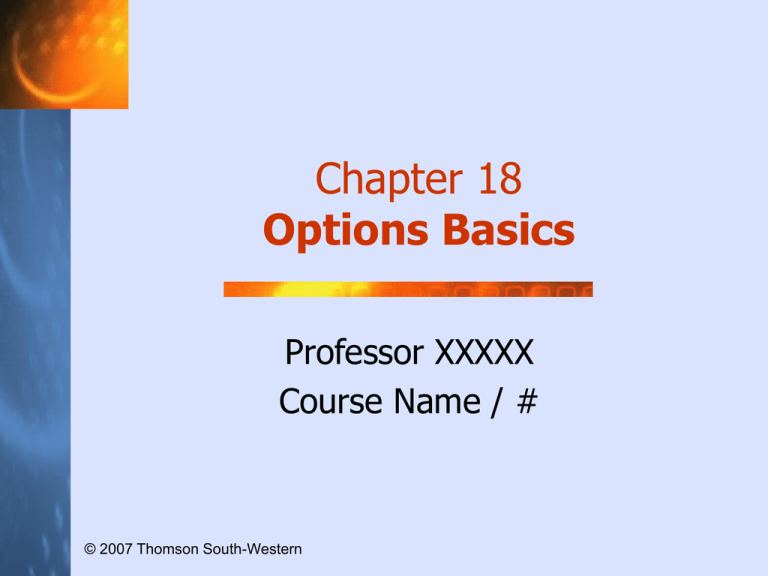
Chapter 18 Options Basics Professor XXXXX Course Name / # © 2007 Thomson South-Western Economic Benefits Provided by Options Derivative securities are instruments that derive their value from the value of other assets. Derivatives include options, futures, and swaps. Options and other derivative securities have several important economic functions: – Help bring about more efficient allocation of risk – Save transactions costs…sometimes it is cheaper to trade a derivative than its underlying asset. – Permit investments strategies that would not otherwise be possible 2 Options Basics Options: contracts that grant the buyer the right to buy or sell stock at a fixed price. Options provide real economic benefit to society. Put-call parity establishes a link between market prices of calls, puts, shares, and bonds. Factors that affect option prices: underlying price, time to maturity, strike price, interest rate and volatility. 3 Options Vocabulary Long position • The buyer of an option has a long position, and has the ability to exercise the option. Short position • The seller (or writer) of an option has a short position, and must fulfill the contract if the buyer exercises. • As compensation, the seller receives the option premium. Options trade on an exchange (such as CBOE) or in the over-the-counter market. 4 Options Vocabulary Call option • Gives the holder the right to purchase an asset at a specified price on or before a certain date Put option • Gives the holder the right to sell as asset at a specified price on or before a certain date Strike price or exercise price: the price specified for purchase or sale in an option contract American or European option 5 • American options allow holders to exercise at any point prior to expiration. • European options allow holders to exercise only on the expiration date. Option Price S = current stock price X = strike price 6 Call Put S>X In-the-money Out-of-the-money S=X At-the-money At-the-money S<X Out-of-the-money In-the-money Option Quotations • Option quotations specify the per share price for an option contract, which is a contract to buy or sell 100 shares of the underlying stock General Expires Strike Electric 7 Call Put 46.31 March 45 4.00 2.38 46.31 June 45 5.88 3.88 46.31 March 50 1.50 5.25 46.31 June 50 3.50 6.50 In-the-money calls Out-of-the-money puts In-the-money puts Out-of-the-money calls Intrinsic and Time Value of Options Intrinsic value Time value 8 • For in the money options: the difference between the current price of the underlying asset and the strike price • For out of the money options: the intrinsic value is zero • The difference between the option’s intrinsic value and its market price (premium) Payoff Diagrams Show the value of an option, or the value at expiration Y-axis plots exercise value or “intrinsic value.” X-axis plots price of underlying asset. Long and short positions Use payoff diagrams for: 9 Gross and net positions (the net positions subtract the option premium) Payoff: the price of the option at expiration date Long Call Option Payoffs 10 Short Call Option Payoffs 11 Long Put Option Payoffs 12 Short Put Option Payoffs 13 Naked Option Positions Naked call option position - occurs when an investor buys or sells an option on a stock without already owning the underlying stock Naked put option positions – occurs when a trader buys or sells a put option without owning the underlying stock 14 Portfolios of Options Look at payoff diagrams for combinations of options rather than just one. Diagrams show the range of potential strategies made possible by options. Some positions, in combination with other positions, can be a form of portfolio insurance. 15 Straddle Positions Long straddle - a portfolio consisting of long positions in calls and puts on the same stock with the same strike price and expiration date Short straddle - a portfolio consisting of short positions in calls and puts on the same stock with the same strike price and expiration date 16 Long Straddle 17 Short Straddle +9 51 69 60 Net payoff Gross payoff 18 Call x = 60, premium = $5, Put x = 60, premium = $4 Payoff Diagrams for Stocks and Bonds 19 Covered Call Strategy Writing covered calls –common trading strategy that mixes stock and call options An investor who owns a share of stock sells a call option on that stock. The investor receives the option premium immediately. The trade-off is that if the stock price rises 20 the holder of the call option will exercise the right to purchase it at the strike price the investor will lose the opportunity to benefit from the appreciation in the stock. Payoff Diagram for Covered Call Strategy 21 Payoff of a Put Option and a Share of Stock – a Protective Put 22 Payoff of a Call Option and a ZeroCoupon Bond 23 Put-Call Parity Following conditions must be met: 1. The call and put options must be on the same underlying stock. 2. The call and put options must have the same exercise price. 3. The call and put options must share the same expiration date. 4. The underlying stock must not pay a dividend during the life of the options. 5. The call and put options must be European options. 6. The bond must be a risk-free, zero-coupon bond with a face value equal to the strike price of the options and with a maturity date identical to the options’ expiration date. 24 Synthetic Put Option Traders can create a synthetic put option by purchasing a bond and a call option while simultaneously shortselling the stock. 25 Put-Call Parity Arbitrage 26 Using Put-Call Parity to Create Synthetic Positions 27 Factors Affecting Option Values 28 Price of underlying asset • Asset price and call price are positively related. • Asset price and put price are negatively related. Time to expiration • More time usually makes options more valuable. Strike price • Higher X means higher put price; lower X means higher call price. Interest rate • Calls: higher “r” means higher call value • Puts: higher “r” reduces put value Factors Affecting Option Values Holding other factors constant, call and put option prices increase as the time to expiration increases. Call prices decrease and put prices increase when the difference between the underlying stock price and the exercise price (S − X) decreases. Call and put option prices increase as the volatility of the underlying stock increases. 29 Calculating Option Prices The binomial options model recognizes that investors can combine options (either calls or puts) with shares of the underlying asset to construct a portfolio with a risk-free payoff. 30 Binomial Option Pricing 31 Binomial Option Pricing Data needed: The current price of the underlying stock The amount of time remaining before the option expires The strike price of the option The risk-free rate The possible values of the underlying stock in the future 32 Multistage Binomial Trees 33 Multistage Binomial Trees 34 Risk-Neutral Method 35 If a combination of stock and options is riskfree, it must sell for the same price as a riskfree bond. If an asset promises a risk-free payoff, riskaverse and risk-neutral investors agree on how it should be valued. Whether investors are risk averse or risk neutral, the binomial model’s calculations are the same. We can assume investors are risk neutral, which gives us a new way to value options.
